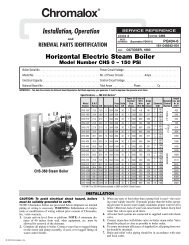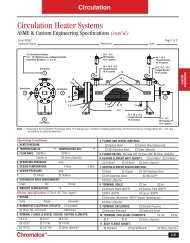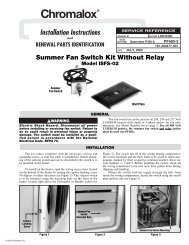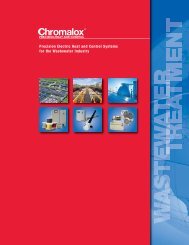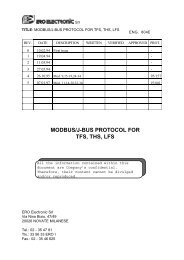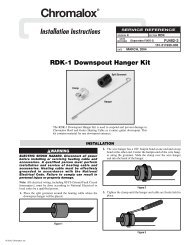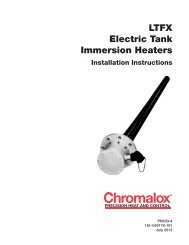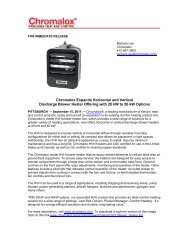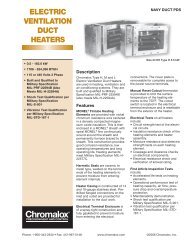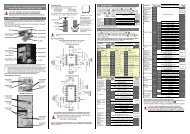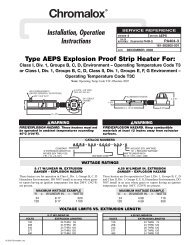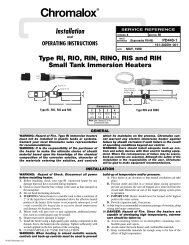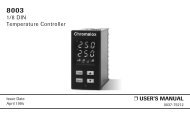Cold Weather Catalog - Chromalox Precision Heat and Control
Cold Weather Catalog - Chromalox Precision Heat and Control
Cold Weather Catalog - Chromalox Precision Heat and Control
- No tags were found...
You also want an ePaper? Increase the reach of your titles
YUMPU automatically turns print PDFs into web optimized ePapers that Google loves.
TechnicalTechnical InformationWiring Practices for Electric <strong>Heat</strong>ersWire Insulation & ConductorsThe selection of wiring materials to be usedin a particular application depends upon theservice Voltage <strong>and</strong> the anticipated operatingtemperatures. The table below lists some ofthe more common code wire constructionsaccording to their temperature limitations.Insulated wires should be derated for elevatedambient temperatures <strong>and</strong> should never beused above their temperature rating. Theoperating temperature of unplated copper wireshould be limited to 200°C (392°F) maximum.A complete listing of wire construction <strong>and</strong>allowable current carrying capacities is shownin the National Electric Code Article 310.General Purpose WiringHigh Temperature Wiring MaterialsMax.Conductor Wire ConstructionTemperature Type (Nickel Plated Copper°C °F (600V) or Nickel Conductors)250 482 TGT Teflon ® - Glass - Tefl on ®TGGT450 842 MGS Mica - Glass - SiliconeMGT Mica - Glass - Tefl on ®594 1100 Bare Maganese NickelWire or Bus Bars withCeramic InsulatorsNote — High temperature wiring materialsare available for field application.Contactor SizingContactors are normally rated for inductive <strong>and</strong>resistive loads. Most electric resistance heatershave negligible inrush or inductive current. Selectcontactors based on resistive load ratings.Using the formulas shown in the paragraphs onwire sizing to determine theamp load per pole (phase). Select a contactorwith the next highest current rating. Use atwo pole contactor for single phase (two-wire)power <strong>and</strong> a three pole contactor for balancedDelta or Wye three phase loads. For heaterloads with high inrush current, refer to productdata information for maximum amperage.Thermocouple Wire & CableThermocouples <strong>and</strong> extension lead wires arecolor coded to aid in identifi cation <strong>and</strong> to avoidinadvertent cross wiring. The following chartsindicate the colors used of different alloys.Thermocouple Color CodingPositiveColorType ( + ) AlloysJ White Iron/ConstantanK Yellow Chromel/AlumelT Blue Copper/ConstantanE Purple Chromel/ConstantanR Black Platinum/Platinum(with 13% Rhodium)S Black Platinum/Platinum(with 6% Rhodium)N Orange Nicrosil/NisilNote — Negative (-) conductor identified with red colored insulation.Max.ConductorTemperatureWireType Construction°C °F (600V) (Copper Conductors)60 140 TW ThermoplasticThermocouple Extension Wire ColorsPositive90 194 RubberColor ColorType Positive Negative Overall ( + )RHHTHWN<strong>Heat</strong> Resistant<strong>Heat</strong> Resistant75 167 RHWTHWRubberThermoplasticThermoplasticT TPX TNX Blue Blue200 392 FEP Tefl on ® B BPX BNX Gray GrayXHHN <strong>Heat</strong> Resistant CrosslinkJ JPX JNX Black WhiteThermoplasticE EPX ENX Purple PurpleMTW <strong>Heat</strong> Resistant CrosslinkK KPX KNX Yellow YellowThermoplastic R or S SPX SNX Green BlackNote — Negative (-) conductor identified with red colored insulation.Electrical Noise & <strong>Control</strong>sElectrical “noise” refers to extraneous electricalvoltages that interfere with legitimate controlsignals. Most electrical noise is introduced byelectromagnetic coupling with fluorescent lights,contactors, power wiring, switches <strong>and</strong> otherarcing devices. Shield control circuit wiring <strong>and</strong>keep thermocouple wires separate from powerwiring. Trace shielded thermocouple lead wiresin a separate conduit for maximum protection.Temperature Limits for <strong>Control</strong>sMost mechanical controls <strong>and</strong> thermostats(control bodies) can withst<strong>and</strong> a wide rangeof ambient temperatures ranging from belowfreezing to over 140°F. Electronic controls,transformers, contactors <strong>and</strong> other electricaldevices are more temperature sensitive <strong>and</strong>extreme temperatures will usually shortenthe life of the component. Most electrical <strong>and</strong>electronic equipment will function accuratelyin ambient temperatures ranging from about30°F to about 130°F. Triacs <strong>and</strong> SCR controlsfrequently require special cooling for full loadratings when operated over 120°F. Refer to theinstallation instructions or contact the devicemanufacturer for recommendations.Wiring Hints for Electric <strong>Heat</strong>ersThe following are some general recommendationsfor wiring electric heating elements <strong>and</strong>assemblies. These recommendations are onlysuggestions <strong>and</strong> are not intended to confl ictwith the National Electric Code or local codes.WARNING — Hazard of Electric Shock. Anyinstallation involving electric heaters must beeffectively grounded in accordance with theNational Electrical Code to eliminate shockhazard. All electrical wiring to electric heatersmust be installed in accordance with the NationalElectrical code or local electrical codesby a qualifi ed person.1. Repetitive heating <strong>and</strong> cooling can causewiring connections to loosen over time.High amperage through a loose terminalcan cause overheating <strong>and</strong> terminalfailure. All heater terminal connectionsshould be tightened to a maximum torqueconsistent with terminal strength. Use asecond wrench or pliers to preventtwisting heater terminals.2. Use str<strong>and</strong>ed wire in applications wherethe power wires to heater terminalconnections may be subject to movement.When using solid wire or bus bar onheater terminals, provide expansion loopsbetween points of support to minimizedamaging stresses due to expansion <strong>and</strong>contraction.3. Solder or silver braze lead connections toheating elements that may be subject toextreme temperatures or vibration. Use aminimum of fl ux to complete theconnection <strong>and</strong> keep fl ux fromcontaminating the heating element.Remove residual fl ux to prevent corrosionof the electrical joint.4. Keep thermostat capillary tubing <strong>and</strong>thermocouple wiring clear of heaterterminals to prevent accidental shortcircuits. Sleeving or insulated tubing isrecommended.5. Use wiring suitable for the anticipatedoperating temperatures. Unless the heateris specifi cally marked for use with lowtemperature copper wiring, high temperaturealloy conductors are recommendedfor connections to the heater terminals.6. Do not use rubber, wax impregnated orplastic covered wire inside terminalenclosures of heaters in high temperatureapplications. These insulations willdeteriorate <strong>and</strong> give off fumes which cancontaminate the heating elements <strong>and</strong>cause short circuits.204




